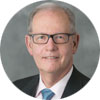Download PDF

Workforce projections are a determinant of policies on physician payment, scope of practice legislation, medical student career choice, graduate medical education funding, and physician recruitment. It is critical, therefore, that they be accurate. However, most projections for future ophthalmologist supply and demand for services are flawed, resulting in a dangerous policy impact.
Why do these studies get it so wrong so often? Some things should be easily definable—the number of ophthalmologists in active practice, the number of ophthalmologists in training, and major demographic trends such as size of the population and changes in mean age. Some factors are less statistically transparent: evolution of disease prevalence, changes in models of practice that affect productivity, and impact of nonphysician providers of care. Others are even less predictable: new technology (think of anti-VEGF drugs in the recent past) and changing patterns of service demands (e.g., fluctuations in demand for refractive surgery).
Amazingly, some studies just simply start with flawed data. The federal Health Resources and Services Administration predicted that between 2005 and 2020 the number of ophthalmologists in clinical practice would decrease by 1%. They then predicted that (depending on the economic model) the need for FTE ophthalmologists would grow 28%-60%—among the highest of all specialties. Another often-cited study predicts a 20% drop in ophthalmologist supply by 2025. How could it be so wrong? The researchers undercounted the number of residents in training by 15%, and they forecasted a further decrease in training slots and a “dramatic” increase in ophthalmologist retirement. Neither materialized.
Last year, the Association of American Medical Colleges released a lengthy update to its projections for physician supply and demand. The data and conclusions contained therein have already been factored into policy arguments for legislation and regulation at the state and federal levels. Key findings of the study include that the demand for physicians will grow faster than the supply, with a projected deficit of up to 121,900 physicians by 2032. The analysis gives a broad range in the projected shortfall due principally to uncertainty as to nonphysician providers’ impact.
Between 2017 and 2032 the authors predict a roughly 10% growth in the U.S. population but a 48% increase in Americans aged 65 and older. Multiple studies, including in ophthalmology, have demonstrated the profoundly greater use of health care services by Americans by advancing decade in the Medicare age group. Other factors at work include economic and geographic differences in health care access and use, lower average intensity of physician work, and an aging physician workforce. (According to Academy data, the average age of ophthalmologists has increased to about 54 years.)
What about the ophthalmology workforce? There are about 18,500 ophthalmologists in practice in the United States. Over the last decades, the number of residents in training has increased 1%-2% per year—far fewer than in optometry. (Ophthalmology residency positions are limited not by the profession itself but by federal funding and local institutional allocations.) On average, fewer than 20 international residency graduates begin practice in the United States each year. Based on Academy membership statistics, there has been no noticeable increase in ophthalmologist retirement rates. In aggregate, therefore, it appears that the rate of increase in ophthalmologists in practice in the United States will not keep up with the rate of increase in Americans over the age of 65.
That statement is far from the whole story. There are substantial geographic disparities in physician supply. Changes in the models of practice (differential incorporation of technicians, technology, telehealth systems, optometrists, and care delivery models) will dramatically impact workforce needs. The interplay between provider aggregation, practice sale, market power, and payment models will affect the calculations. State-based optometric scope of practice changes may have an effect.
The biggest wild card in demand for ophthalmologist services is technology. Want a game-changer? Consider an eyedrop that slows cataract progression, a procedure that reverses geographic atrophy, and/or a neuroregenerative procedure for glaucoma. It is not an issue of whether, but of when.
For all of the above reasons, workforce projections are essential but must be interpreted in light of their intrinsic, unavoidable shortcomings. Policy makers must critically review study methodologies. In making professional decisions, ophthalmologists must account for local factors of demography, need, and demand for services. They must also maintain flexibility for unanticipated—frequently technology-driven—changes in the environment of ophthalmic practice.